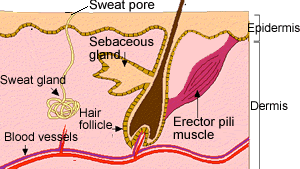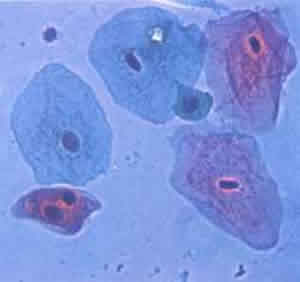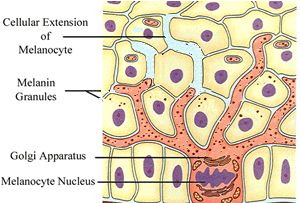Skin
The skin is composed of two
layers:
- an outer layer called the epidermis
- an inner layer called the dermis.
Click to see a larger view of the cross
section of the skin worksheet.
The epidermis is primarily responsible for protection of the body by providing a tough, flexible and water proof covering.

The epidermis is made up of two parts of epithelial cells. The top most layer of the epidermis is known as the stratum corneum and has epithelial cells that are flat and overlap each other, as seen on the right. At the bottom of the epidermis is a layer of cells, known as the basal or germinal layer, which is constantly dividing. This layer is the source of new cells that are constantly needed to replace old and worn out cells as they flake off the surface of the skin. Dead cells flaking off the surface of the skin cause dandruff. The new cells grow and are pushed upwards towards the surface. As they go further up they become flatter and wider and develop a build up of a protein called keratin. As they near the surface of the skin the epithelial cells die. These dead cells provide a tough, thick, waterproof, layer that completely covers the body.

The layer of dead cells, stratum corneum, varies in thickness in different parts of the body depending on the wear and tear on that particular part. The skin on the soles of our feet, for example, is thicker than the skin on our finger tips. The relative thickness of each area is shown on the right, where "A" represents the thickness of skin on the soles of our feet and "B" the thickness of skin on our finger tips.


Touch receptors are found in the
During hot days the skin looks red because tiny blood vessels close to the surface of the skin dilate. These blood vessels are found in the
Dandruff is
Dandruff is
The germinal layer separates the dermis from the epidermis. This layer
The skin on the palm of one's hand is thicker than on other parts of the body. What is the best explanation for this?
Sebaceous glands produce
Many advertisements mention skin creams with vitamins that rejuvenate the skin. Why is this rejuvenation by vitamins a false claim?
What part of the skin must be targeted to stop dandruff completely? What effect would this have on the thickness of the skin?
Acne is a result of infection by bacteria of hair follicles. The best cure is washing with an
How do sebaceous glands help stop acne from developing?
Skin cancer is common amongst those that spend long hours unprotected in the sun. How does the skin guard against U.V. radiation?
Antiaging creams are big business. Some creams are said to contain elastin and collagen that rejuvenate the skin. Look at the commercial on the right. Argue against such treatments.
What are elastin and collagen?
What is their purpose in the structure of the skin?
Some people argue that the anit-wrinkle creams are nothing more than moisturising creams that help the skin absorb water. How does this remove wrinkles?
The advert on the right makes mention of many impressive sounding chemicals. To the normal person with very little background in science this can be very convincing proof as to the power of this skin product.
It makes mentin of:
- hydrolysed collagen. What is this? Is it simply collagen added to water?
- What is hyaluronic acid? The chemical structure of this acid makes it able to attract many water molecules to it. This accounts for the special interest in hyaluronic acid for the treatment of wrinkles in dermatology. When injected under the skin, it makes the site appear full thus smoothing out lines and wrinkles for up to six months.
Where is hyaluronic acid found in the body and what is its function?
- Why is Vitamin C used for in skin creams? What is an antioxidant?
- What are amino acids used for by the body? Can they be absorbed directly through the skin? Explain.
- What is L-glutamine.? Why is it so popular in skin care?
- What is L-glycine? The add states that it is a part of collagen and low glycine levels can cause skin damage. This statement is true albeit misleading. Why?
